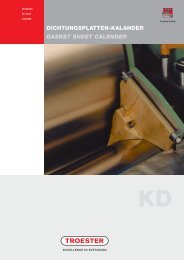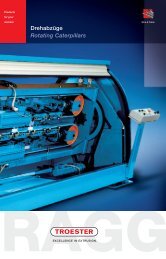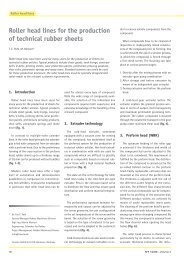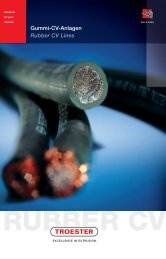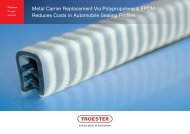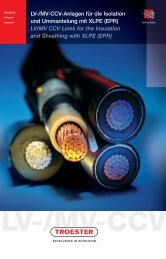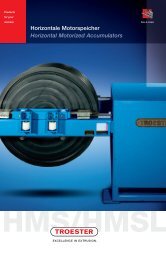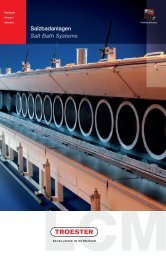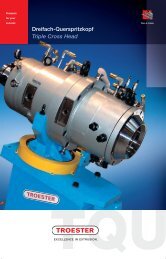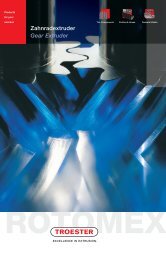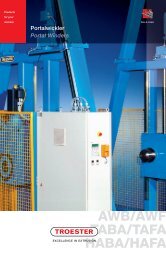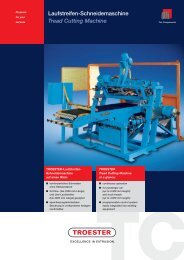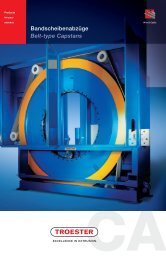Erfolgreiche ePaper selbst erstellen
Machen Sie aus Ihren PDF Publikationen ein blätterbares Flipbook mit unserer einzigartigen Google optimierten e-Paper Software.
The Single-Roll <strong>Roller</strong> DieSystem at a Glance:■ high production capacity■ excellent product precision■ Very low tooling costs■ short change-over times due toeasy tooling changes■ suitable for undercut profiles■ material swelling after shaping canbe controlled by roll speed androll/die distance■ smooth material flow for profileswith great thickness variations(with straight product path)■ high material density due to reducedor avoided porosity■ low compound temperatures dueto low die pressure■ produced sheets remain adhesivefor later coating with other sheets■ low investment cost as comparedto calender systems<strong>EWK</strong>ge (mit 2 x <strong>Roller</strong> <strong>Head</strong> und <strong>EWK</strong>)(with 2 <strong>Roller</strong> head and <strong>EWK</strong>)Single-Roll <strong>Roller</strong> DieSystemsThe Single-Roll <strong>Roller</strong> Die systemgenerally consists of a cold-feedpin-type extruder and a Single-Roll<strong>Roller</strong> Die. Thus it is the optimalcombination of the easy operationof direct extrusion and the qualityimprovingcharacteristics of thecalendering process. The Single-Roll <strong>Roller</strong> Die can be used toproduce high-quality profiled rubbersheets in different widths andthicknesses, such as, for example,sidewalls for automobile tires, rimstrips, profile strips (also withundercut and highly sensitive, thinwall sections), treads, apex strips,innerliners and rubber sheets forconveyor belts among many otherthings.The rubber compound plasticized inthe extruder is given its final shapeby the head of the Single-Roll <strong>Roller</strong>Die, which is flanged onto theextruder. It essentially consists ofthree parts, which together formthe shaping gap: the temperaturecontrolledhead with flow channelsincorporated into it for pre-distributionof the material, the temperature-controlledroll and anexchangeable plate die on thehinged upper part of the head.The rubber compound is fed intothe shaping gap under low pressure,i. e., without excessivelyincreasing the temperature.As the roll turns,a dragging effect occurs in thehead area and in the shapinggap, which is caused by thecompound adhering to the temperature-controlledroll surface. Byad-justing the roll temperature andthe overall speed of the roll to theextruder output and the take-offspeed, even the most complex profileswith great thickness variations,undercut and long, angled tips canbe easily shaped. An importantfeature is the high product precisionwith low material swelling, whichsimplifies the production and adjustmentsof the profile strips. Thegeometry of the profile correspondsvery closely to that of the plate die,which greatly reduces expensiveand time-consuming rework.The Single-Roll <strong>Roller</strong> Die makeshigher production speeds possibledue to lower compound temperatures(in comparison with otherextrusion systems). Nearly the sameproduction speed can be achievedas with calender lines, as long ascorresponding compound quantitiesare offered. The Single-Roll <strong>Roller</strong>Die system is extremely easy tooperate: clamping the hinged headupper part to the fixed lower partusing two hydraulic cylinders on thesides. A wedge comb hydraulicallyfixes or releases the plate die. Thismakes the shaping final plate dieeasy and fast to exchange forproduction changes. In order tooptimize the thickness of the profile,the roll can be moved using motordrivenspindles, which allows thedistance between the plate die androll to be precisely adjusted.Additional measurement technologysupports the already easy operationof a Single-Roll <strong>Roller</strong> Die productionunit. Screw and roll speed canthus be adjusted to one anotherdepending on the compound pressurein the head, and compoundpressure, temperature, roll speedand the gap size can be digitallymeasured. The product can alsobe measured tactilely or contactfree.Which of the different optionsin measurement technology areused can be determined byindividual requirements.



